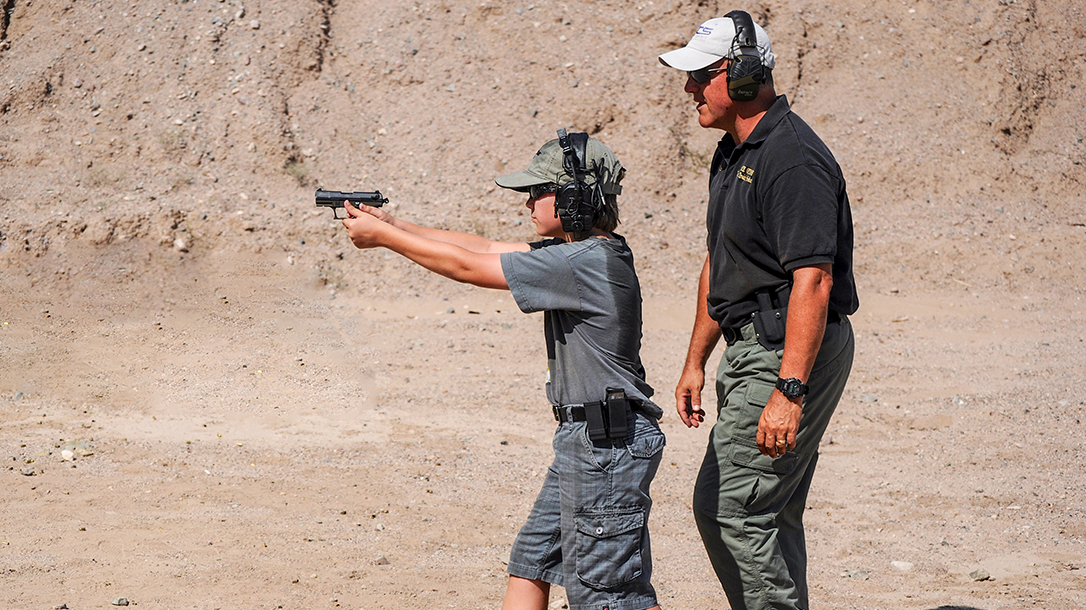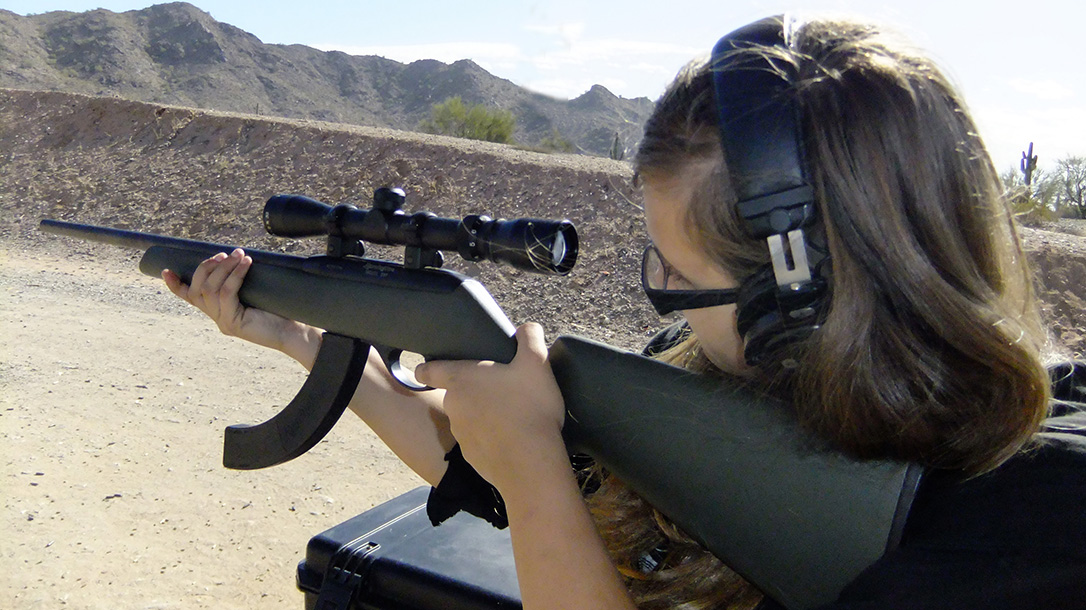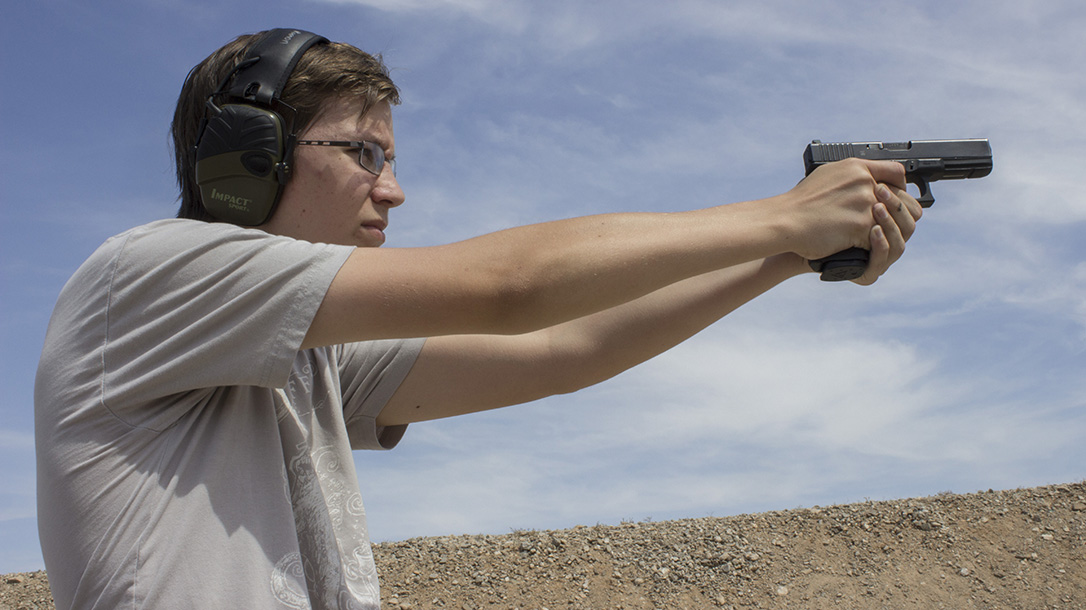My highest career priority is enabling future generations to enjoy the shooting freedoms. One of the most critical components of that is introducing new shooters to the sport. To that end, I’ve compiled some helpful tips and suggestions for mentors and beginners when initiating a new shooter.
Figuring Eye Dominance for New Shooters
It starts with the eyes. Clearly aligning a weapon’s sights on a target and hitting it seems intuitive, but many folks are handicapped and don’t know it. We’re not talking about blurry, correctable vision but cross-eye dominance. This occurs when someone is, for example, right-handed but their left eye is dominant. The same holds true for southpaws. When the dominant eye doesn’t match the strong hand, it makes it difficult to shoot without correction.
Advertisement — Continue Reading Below
I’ve worked with hundreds of shooters new to handguns, rifles, shotguns and archery. The first exercise I perform with new shooters is to check for coordinated eye dominance. Start with a simple exercise. Extend your arm, stick your thumb up and use your thumbnail as your “sight.” Keep both eyes open and cover a distant spot with your thumbnail. Now close your left eye. Does your thumb still cover the spot? Open both eyes again and cover the same spot. Now close your right eye. Does your thumb appear to jump to the side of your target? If so, you are right-eye dominant.
If your dominant hand matches your vision, it’s time to start shooting lessons, but if they don’t sync up, there are multiple remedies. For those fortunate enough to be ambidextrous, just switching the trigger hand and shoulder should fix things. However, if that can’t make it more comfortable to shoot, specially altered shooting glasses are an option. Take the glasses and cover the lens of the dominant eye with dark tape or paper. This will force the non-dominant eye to align the weapon’s sights.
Proper Protection
While I’m talking about protective eyewear, it’s important to mention the importance of proper hearing protection for anyone shooting or nearby. Without hearing protection, even a few shots can create long-term hearing loss that might not manifest for decades. Additionally, damaged hearing from exposure to gunfire seems to be cumulative. I’ve been almost fanatical in protecting my hearing from gunfire, but occasional exposure from hunting is starting to take its toll.
Advertisement — Continue Reading Below
Aside from saving your ears, hearing protection for new shooters helps in other areas. That bang you hear when pulling the trigger is a shockwave that travels through the air. It can be felt. The larger the cartridge, the larger the shockwave. When you couple that shockwave with the intimidation factor of firing a gun, it can be unnerving. A good practice for new shooters is to double up on hearing protection. A pair of foam plugs covered with earmuffs will help minimize the intimidation factor.
This brings me to one of my favorite tools for first-time shooters—sound suppressors. Also known as “silencers,” though that name is a misnomer, they have served so well that I believe they should be used whenever possible to introduce new shooters to the sport.
I’ve lost count of how many times I’ve incorporated suppressor use into introductory shooting lessons, but a recent example makes the point.
Advertisement — Continue Reading Below
Starting a New Shooter
My wife’s friend, Markay, is from California, and she’s a typical mother of three who had never handled a gun. She visited our farm for a couple of days, and during her visit, my wife asked her if she would like to learn to shoot.
Markay was curious and a bit intimidated about the opportunity, but her excitement won out. To keep things simple, I grabbed a Ruger 22/45 pistol fitted with a SilencerCo Spectre 22 suppressor. It also wears a Trijicon RMR miniature reflex sight to keep aiming simple. After a quick safety lesson, we walked out onto the back porch, and I tossed an empty Mountain Dew bottle into the backyard. Quickly going through things such as trigger and breathing control, she was delighted that she could hit the target with reliability after just a couple of magazines.
We stepped the lesson up a notch by grabbing another pistol, a 9mm Honor Guard. Then, we picked up an IWI Tavor SAR in 5.56mm NATO fitted with another SilencerCo suppressor, the Saker ASR. Then, we walked 100 yards to my range, where I had some reactive steel silhouettes set up. We started again with the Ruger 22/45, and I quickly had Markay banging away at the steel. Her confidence building, we donned earmuffs and switched to the 9mm. That let us cover the basics of handgun sights and how to safely load and unload the pistol. In no time, we moved from 7 yards to 25 yards, and she was making center-mass hits with regularity.
Advertisement — Continue Reading Below
From New Shooter to Shooter
When she ran through a 50-round box of 9mm ammo, it was time to move to a rifle lesson. Again, I went through a safety briefing specific to the IWI Tavor SAR and how to align its flip-up iron sights. Shots at 10 yards built her confidence, and we quickly moved back to 25 yards. She was delighted to hammer the steel with every shot. I also removed the Saker for a few shots so she could get a feel for the difference of shooting without a suppressor. I knew Markay was having fun when she started asking for more loaded magazines.
In 45 minutes, Markay went from having never fired a gun to safely learning how to manipulate and make consistent hits with the same weapon platform carried by the Israeli Defense Forces. She also learned that sound suppressors are not only legal, but also a logical way to reduce muzzle blast.
Advertisement — Continue Reading Below
Be Careful of Too Much Power with New Shooters
I learned a long time ago that new shooters shouldn’t be subjected to heavy recoil—be it from a rifle, shotgun or pistol. I worked for the National Wild Turkey Federation for 11 years, and the organization hosts a national JAKES—the NWTF’s youth program—weekend at its headquarters in Edgefield, S.C., every summer. Each year, one of the most popular events is the turkey gun patterning station. Each participant is shown some basics of safe gun handling and learns how to pattern a turkey gun.
I recall one child who was about 12. He stood in line and watched several other larger-framed teenagers step up to the bench and shoot. Many of the older boys had some experience shooting 12-gauge turkey guns and avoided the wimpy .410s and 20-gauge turkey guns as they displayed their testosterone-induced bravado. When the little guy stepped up to the bench, I already had a Thompson/Center Contender single-shot .410 in hand to begin his one-on-one lesson. He confidently informed me that he was going to shoot the 12-gauge. I tried to talk him out of his decision, and even asked if his parents would approve of his decision. I made a mistake—one I haven’t repeated—when I reluctantly let him shoulder a Remington 870 and send a 3-inch magnum 2-ounce turkey load downrange. The tears flowed, and he spent the rest of the afternoon with an ice pack on his tender shoulder.
That young man’s painful experience taught me several lessons besides the obvious. First, he taught me that no matter what a novice says, the mentor should never subject a small-framed shooter to heavy-recoiling firearms. At best, it will create a flinch. At worst, it will turn them off to shooting.
Advertisement — Continue Reading Below
Taming Recoil for New Shooters
Many shotguns and rifles come equipped with a soft recoil pad. Most factory pads offer some recoil absorption, but more advanced recoil-absorbing pads are available from sources such as Brownells. Ask your local gunsmith for advice on which pad will help absorb more recoil than a factory pad.
Gun weight and action type have a lot of bearing on how much recoil you will feel when you shoot. Lightweight single-shot and double-barreled guns can be almost unbearable when shooting high-velocity magnum game loads. If a gun has a lot of drop in the comb of the stock, the sensation of recoil becomes greater. Fitting squarely into this category are “youth” 20-gauge single-shots that are chambered for 3-inch loads. If you are introducing a new shooter to firearms, be sure to stick with light field loads during practice sessions.
Advertisement — Continue Reading Below
You can raise the comfort level by opting for a pump-action shotgun. Simply put, these guns kick less because they are heavier. A shooter will feel even less recoil when shooting semi-auto shotguns because the guns use some of the recoil energy during the reloading process instead of transferring it all to the shooter.
You can install aftermarket add-ons and recoil-absorbing devices inside of the buttstock of a rifle or shotgun. There are also devices to go inside the magazine tube on repeating shotguns. These nifty gizmos work on the principle of hydraulics to help spread felt recoil out over a longer period of time, much like when you shoot a gas-operated semi-automatic shotgun. PAST recoil pads really help, too, when attempting to tame recoil. You wear these pads over your shirt, putting a layer of leather and foam between you and the gun. When I’m shooting, I regularly wear a thinner shotgunning pad under a thick rifle pad.
Proper Form
Proper shooting form is one of the simplest ways to help you shoot more consistently and feel less recoil. When I am working with children, I emphasize that they mount a rifle or shotgun in their shoulder pocket instead of lower on their arm. Just as important is how they hold their face to the stock. Their mouths should be closed, and their teeth should be lightly clenched to firm up their cheek muscles. When they press the comb of the stock firmly to their face, it should rest against tight cheek muscles in the same place for each shot.
Advertisement — Continue Reading Below
Facial surface-area contact with the stock is the key to comfortably facing stout-kicking long arms. If you lightly press your face to the stock to mentally avoid the inevitable recoil, the gun will pick up momentum at the shot and punch you in the cheek. On the other hand, if you’re firmly in contact with the stock, it becomes more of a push, as the weight of your head helps absorb the blow.
In the end, remember these shooting tip to make that first-time experience more enjoyable, or incorporate them into your repertoire when you mentor a new shooter.


























